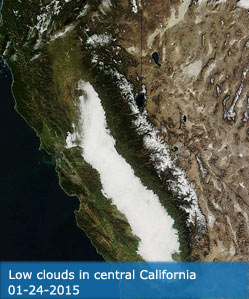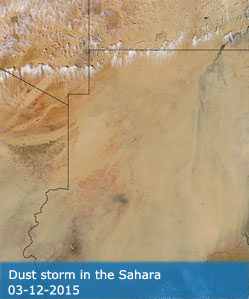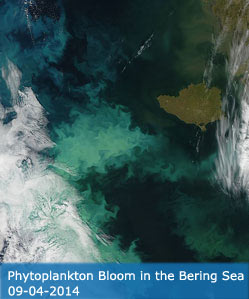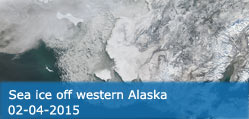Direct Broadcast
One of the unique features of the MODIS instrument is its Direct Broadcast capability – in addition to storing data for later download at designated intervals, MODIS immediately broadcasts the raw data it collects on the chance that someone on the ground below is listening. The Terra MODIS instrument was one of the first satellites to constantly broadcast data for anyone with the right equipment and software to download, free of charge.
The MODIS direct broadcast system began with Terra on Monday,
April 24, 2000, and for Aqua on July 12, 2002. Both broadcast
full-time except when passing over any of NASA’s Deep
Space Network antennas that are actively tracking a remote
spacecraft. It is estimated that this will occur less than
two hours per day. (For more information, please visit the
Terra
Direct Readout Website.)
Generally, spacecraft collect data and store it on board until
it passes over a ground station set up to receive the data,
at which point it transmits the data in one large batch. This
avoids losing data taken when the spacecraft is out of sight
of any ground stations, such as when it is over the ocean.
But the advantage to continually broadcasting the data is
that many sites have the antennas and other necessary equipment
to receive and process MODIS Direct Broadcast data.
The data stream carries the data from all 36 spectral bands
for the entire MODIS field of view. The data can be transmitted
directly from the spacecraft to ground stations equipped with
an average 3m or larger X-band receiving system and appropriate
hardware and software. The Overpass Predictor can be used
to determine when there will be a Terra or Aqua spacecraft
overpass at any location that may have a MODIS Direct Broadcast
receiving station.
The following sites have direct broadcast imagery and/or more
information regarding direct broadcast:
LANCE MODIS Rapid Response
https://earthdata.nasa.gov/data/near-real-time-data/rapid-response
Rapid Response provides imagery from the MODIS instrument. All imagery can be viewed through Worldview. To help users, the imagery have been organized into 10 application categories to assist users in monitoring and
analyzing a variety of natural and man-made hazards and disasters (e.g. ash plumes and fires). MODIS Subsets and MODIS Near Real-Time (Orbit Swath) Images are also available.
The University of Wisconsin – Madison’s
Space Science and Engineering Center (SSEC)
http://eosweb.ssec.wisc.edu/cgi-bin/eosdb.cgi
Provides access to images and information on Terra and Aqua
MODIS direct broadcast data for the current day. It also provides
links to the actual data, orbital tracks, and the hardware
and software necessary to receive direct broadcast data.
The University of Miami’s Center for Southeastern Tropical Advanced Remote Sensing (CSTARS)
http://www.cstars.miami.edu/
The CSTARS ground station (which falls under RSMAS) acquires DB data and processes to 250m corrected reflectance, SST, LST, NDVI, and OC. The data is processed automatically after acquisition and streamed to their
website.
The Goddard Space Flight Center’s Direct Readout
Laboratory
http://directreadout.sci.gsfc.nasa.gov/
Provides access to Terra and Aqua MODIS direct broadcast data,
Quick-Look images, viewing software, ephemeris data, and information
about the hardware and software necessary to receive direct
broadcast data. This site also provides Direct Broadcast data
for other instruments on the Aqua and Terra spacecraft.
The University of South Florida's MODIS Direct Broadcast
Data Products
http://modis.marine.usf.edu/
Provides access to a variety of direct broadcast data images
including true color, SST, Chlorophyll a_2, Cholorophyll a_3,
and has links to various coverage areas.
USDA Forest Service Remote Sensing Applications Center (RSAC)
http://activefiremaps.fs.fed.us
The USDA Forest Service utilizes MODIS DB data to support interagency, strategic fire management. Access to MODIS imagery, fire detection data and other geospatial products are provided for near real-time active fire
detection and monitoring covering the United States and Canada.
University of Tokyo's Institute of Industrial Science MODIS
Data Service Center
http://siaiis.tkl.iis.u-tokyo.ac.jp/sat-info.php
Provides direct broadcast imagery, as well as variety of archived data images, of South and East Asia. There are a number of data products spanning the science team disciplines also available of this region.
New Tools for Quantifying Global Volcanic Heat Fluxes and Delivering Data to
the Volcanological Community
http://modis.higp.hawaii.edu
Using infrared satellite data provided by the Moderate Resolution Imaging Spectroradiometer (MODIS), scientists at the Hawai'i Institute of Geophysics and Planetology, University of Hawai'i, have developed an automated system which maps the global distribution of thermal hot-spots in near-real-time, and displays the results on this website.





